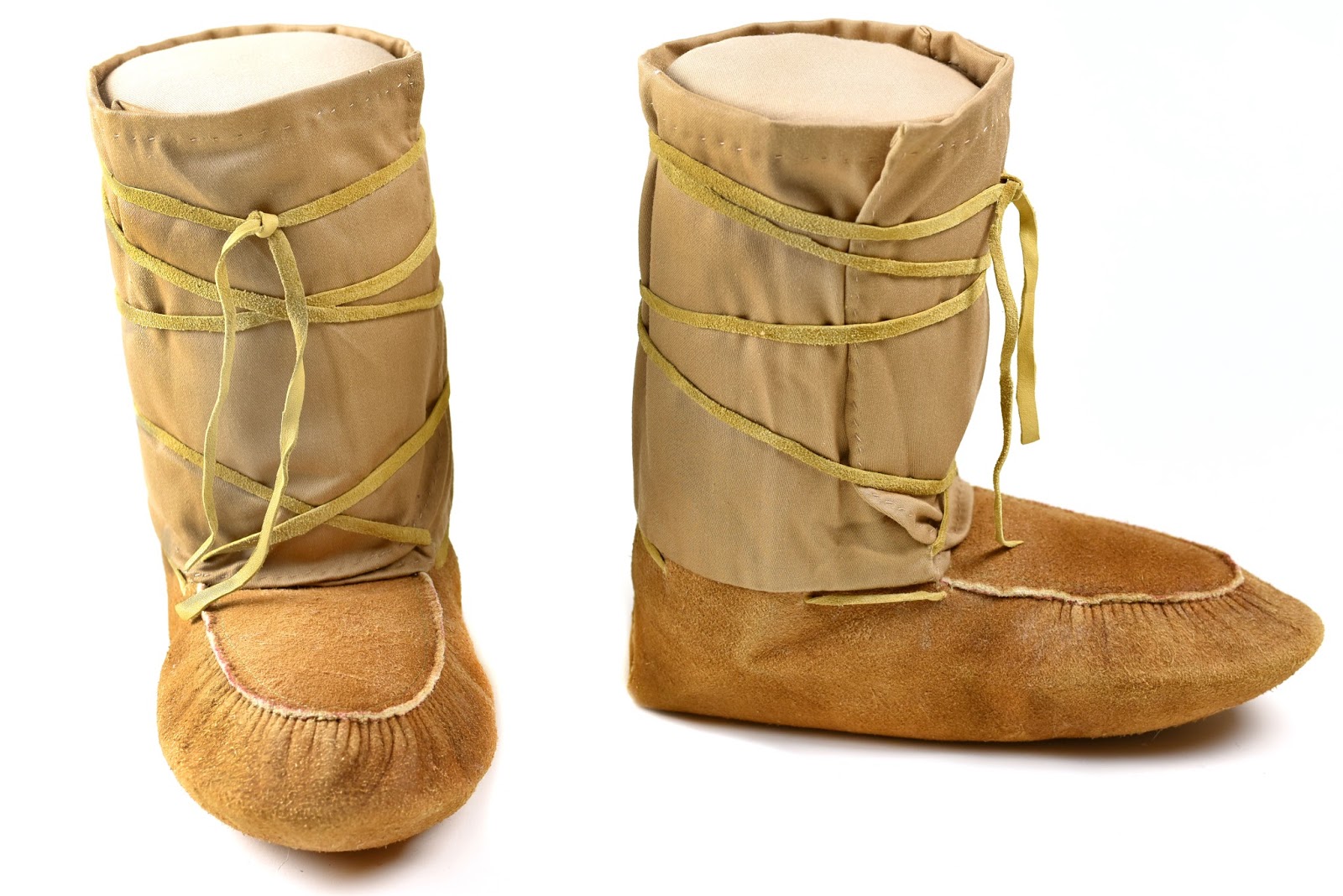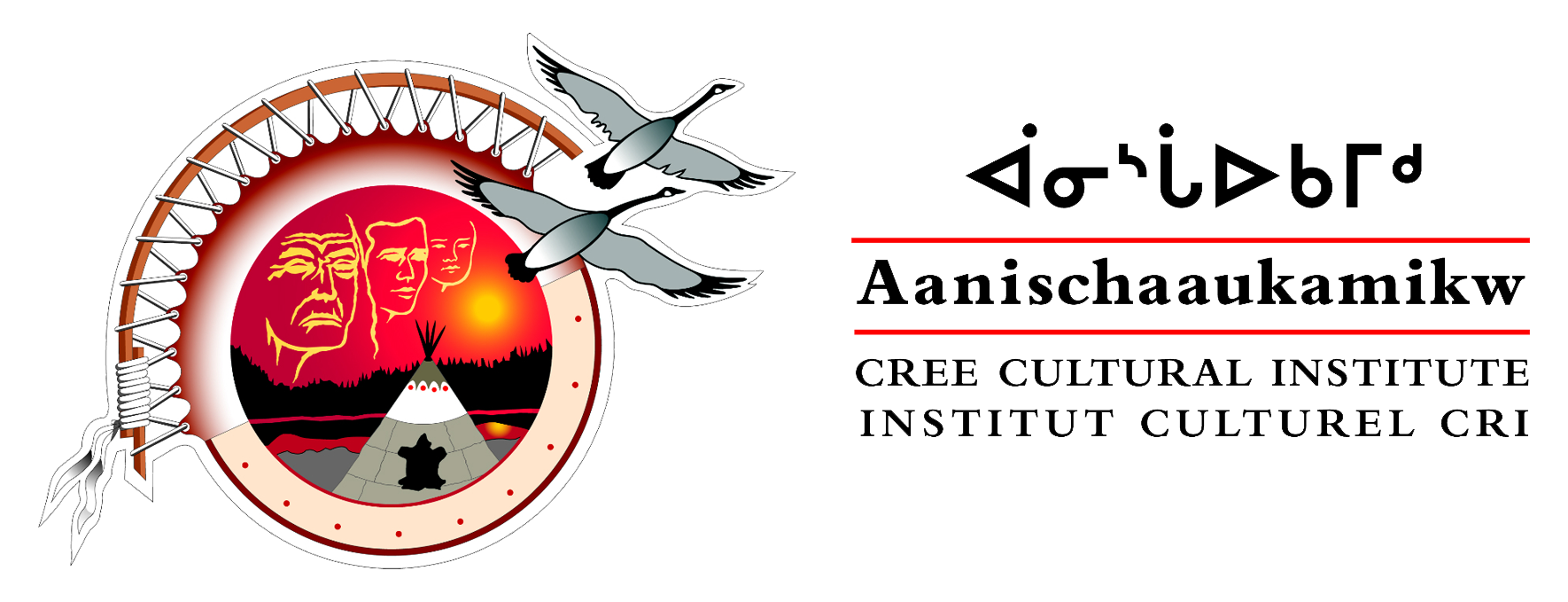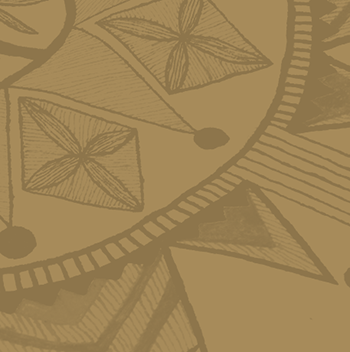Preparing for Siikun in Eeyou Istchee
by Annie Bosum, with Elder Eva Bosum
Spring in the bush offers many activities
including the move to a new camp. I learned this from my uncle and aunt, George
and Eva Bosum (Photo 1), who always demonstrated a love of the land as our ancestors
did before them. Like all of their
generation (born in the late 1920s), the land is their soul–they live and
breathe what the land provides, relying on the animals and forest for clothing,
warmth and nutrition.
| (Photo 1 – George and Eva Bosum making snowshoes. Anna Bosum Photograph Collection.) |
All year
round, they were on the land, hunting and practicing traditional activities, demonstrating
typical characteristics of what we call ‘Dab-Eenouch’, people who are competent
in their knowledge of how to live off the land. My late uncle George knew his
land like the back of his hand and knew the traditional Cree names of each lake
and river. When the mining companies
began moving into the Chibougamau area in the 1950s, George and Eva were the
last people to abandon their old shack at Dore Lake. They did not relocate into the town of
Chibougamau like the other Cree people, and searched instead for a suitable
camp at Chibougamau Lake. With the
permission of the tallyman, the late Philip Shecapio Sr., they built a cabin to
stay in for the summer months, returning to their hunting territory, North of
Lake Opataca in late August or early September each year.
In the
summer months they set up fish nets and lived on fish around Chibougamau
Lake. In Autumn (Takwaachin), Winter (Pipun),
and Spring (Siikun) they traveled to
their hunting territory to hunt small game, bear and moose. Together, with perfect skill and accurate
knowledge, they worked continuously in quiet strength, preparing toboggans,
snowshoes, moccasins and mittens, using only materials from the land. They
traveled effortlessly as a team on foot, on snowshoes and with the canoe,
delightfully in tune with nature and oneness with the woods.
One early
Autumn, we flew by plane to our hunting territory. We temporarily camped in a
small canvas tent, using spruce poles to hold it up, and with pine boughs as
flooring. I remember my uncle and aunt
working tirelessly from dawn to late evening to build the aschiiukamikw: a moss
dwelling which would become our Fall/Winter dwelling, or sometimes a takwaachihtaaukamikw, which was made out
of logs and moss. This type of dwelling
was built using black spruce trees stripped of their bark to make logs, and
moss from the earth. I remember it being
small, but quite comfortable and warm. A
hole was first dug about 3-4 feet deep, underneath the soil was soft and easy to
shovel. The area where we lived was both
marshy and dry, with an abundance of moss, black spruce, jack pine and white
birch.
When the time
would come to move out of our takwaachihtaaukamikw,
Uncle George would go ahead to locate the perfect spot for our siikunihtaaukamikw, a place closer to
abundant water to hunt the migrating geese and ducks. The kichiihchaaukimkw
is a square lodge made with two or three split logs, cut from spruce trees, on
each of the four sides, with canvas walls and a tarp secured with nails (Photo
2).
| (Photo 2 – George, Eva and Harry Bosum at spring camp. Anna Bosum Photograph Collection.) |
Next my Uncle
would get his taatiyaakanaaskw toboggan
to move the canoes to the siikunishiwin.
This type of toboggan is used to carry a 9 or 8 foot canvas canoe. He waited until the snow and ice turned hard from
Spring rains and cold nights. This type of snow is called uteyaau. The dogs pulled the
toboggan with the canoe, with my Uncle walking in front and my Aunt walking behind,
carrying a wood pole to push the toboggan when needed (Photo 3).
 |
| (Photo 3 – Charlie and Louise Jimiken, 1970-1971, showing an example of a taatiyaakanaaskw and a taashipitaakin in the background. Photographer: Adrian Tanner.) |
In the early
morning, when the ice was hard, you could walk without snowshoes, wearing only kâ chinwâch maschisin (Photo 4). My Aunt and Uncle left very early so they
could return before the sun made the ice too slushy for travel. At the new camp, the canoe was hung on a teshipitaakan. The taatiyaakanaaskw was left at the new camp, so the return journey used
only a small sled, carrying snowshoes and other necessities. A few more trips
with the dog sled moved everything needed to our new siikunishiwin.
 |
| (Photo 4 – ACCI 2012.09.115ab. From the Cree Action Collection.) |
ᐊᔅᒌᐅᑲᒥᒄ | aschiiukamikw | a moss dwelling |
ᑕᐧᑳᒋᐦᑖᐅᑲᒥᒄ | takwaachihtaaukamikw | Fall/winter dwelling made of moss / |
ᑲᒌᐦᒉᐅᑲᒥᒄ | Kachiihcheukamikw | Square lodge with split logs |
ᑖᑎᔮᑲᓈᔅᒄ | taatiyaakanaaskw | Wide, long toboggan for transporting a |
ᐅᑌᔮᐤ | uteyaau | The surface of the snow freezes hard |
ᑌᔑᐱᑖᑲᓐ | teshipitaakan | A raised platform cache with four legs cut from trees and two |
ᑳ ᒋᐧᓈᒡ ᒪᔅᒋᓯᓐ | kâ chinwâch maschisin | Tall moccasins with warm duffle |
ᓰᑯᓐ | Siikun | Spring |
ᓰᑯᓂᔑᐧᐃᓐ | siikunishiwin | Place to spend Spring |
ᐊᔅᒌᐅᑲᒥᒄ | takwaachin | Autumn |
ᐱᐳᓐ | pipun | Winter |
ᓰᑯᓂᐦᑖᐅᑲᒥᒄ | siikunihtaaukamikw | Spring Dwelling |




